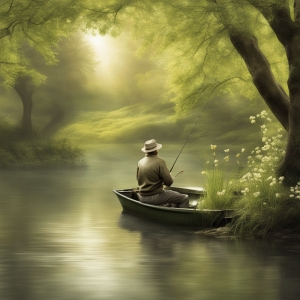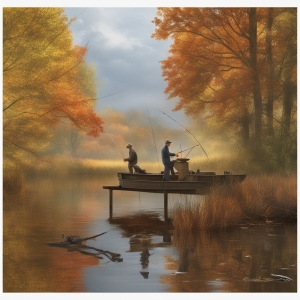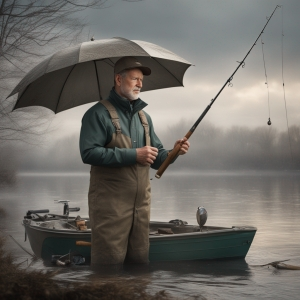Table of Contents:
Welcome to the fascinating world of fishing! You've made the right choice by choosing this exciting sport as your hobby. At Buzzerfish, we're here to guide you through every step of your journey. In this article, we're focusing on a crucial aspect of fishing: understanding the seasons. Each season brings unique conditions and challenges, requiring different tactics for success. We will walk you through the various strategies tailor-made for each season.
Fishing Throughout the Year: An Introduction
Fishing isn't a one-size-fits-all pursuit. It's a practice borne of keen observation, adaptability, and the ability to understand and respond to the ever-changing conditions of the natural world. The best anglers know the importance of adjusting their methods based on the season. Why? Because the behaviour of fish changes dramatically from season to season.
Fish, much like other animals, are significantly influenced by the weather. In colder months, fish move less and eat less. Through understanding the seasonal patterns, not only can you better predict where fish will be, but you can also anticipate their behaviour and improve your success rates.
In this guide, we'll dive into how our fishing tactics should change with the seasons, starting with winter and moving through to autumn. We'll discuss the changes in fish behaviour, the best areas to target, and the specific tactics you can employ throughout the year for successful fishing.
Understanding the Seasons: Implications for Angling
Each season influences the underwater universe in distinctive ways. Understanding how fish react to these seasonal shifts can dramatically improve your angling success.
In winter, cold temperatures push many fish into a semi-dormant state known as torpor, where they conserve energy by reducing activity and feeding less frequently. However, this doesn't mean they aren't catchable. Targeting deeper waters where fish congregate for warmth could yield surprising results.
As temperatures slowly increase in spring, fish come out of torpor and begin feeding aggressively to replenish energy reserves, an excellent opportunity for anglers. This is also a time when many fish spawn, providing exciting chances to catch some truly trophy specimens.
Summer brings warmer temperatures and longer days, often leading fish to seek shelter in cooler, deeper waters during the day. Early morning or late evening, when the water cools, are typically the most productive times to fish.
In autumn, falling temperatures trigger many fish to feed heavily in preparation for the lean winter months. This 'feeding frenzy' can create fantastic opportunities for the patient and observant angler.
By adjusting your tactics based on the seasonal behaviors and preferences of fish, you're likely to see a significant boost in your catch rates. Let's explore this in more detail in the following sections.
Pros and Cons of Fishing Tactics Throughout the Seasons
| Season | Pro | Con |
|---|---|---|
| Spring | Fish are more active and hence easier to catch due to rising temperatures | Changing weather conditions can affect fish behavior unpredictably |
| Summer | A variety of species are abundant and active | High temperatures can make some fish less active |
| Autumn | Fish are typically feeding aggressively to prepare for colder months | Falling temperatures can cause fish to move to deeper waters, making them harder to find |
| Winter | Fish are often found in predictable locations due to cold temperatures | Need for specialized equipment like ice rods, making fishing more challenging and expensive |
Spring Fishing: Awakening of Nature

Spring, accented by the blooming of nature, signals the resurgence of fishing activity after the chill of winter. As the water slowly warms up, metabolism rates of fish increase. This transition ushers them out of their torpor state and into an active feeding phase to regain energy. Their increased hunger makes them more likely to bite, offering abundant opportunities for fishing enthusiasts.
Generally, fish animals move from the deeper waters of their winter homes into shallower areas. During the spring spawning season, specific species such as bass move into shallow spawning beds, making them easier to target for anglers. It’s an opportune time to use lures that mimic the smaller fish bass typically feed on during this period. Brightly colored or shiny lures are a solid choice to grab the attention of these hungry fish.
When it comes to timing your fishing trips in spring, it's useful to pay attention to water temperatures. The warmth of the afternoon often results in more significant fish activity. Aligning your trips with these moments could lead to a fruitful fishing session and some impressive catches to celebrate the new season.
Summer Fishing: High Season Tactics
Summer is often seen as the peak of the fishing season. With increased daylight hours, warmer water temperatures, and abundant food sources, fish are usually more active during this season. One key thing to note, however, is that the warmer the water, the less oxygen it holds. This often pushes fish into cooler, deeper waters during the day, except for early in the morning and late in the evening when the waters have cooled.
To adjust to this change, choose cooler parts of the day for fishing. Dawn and dusk are prime feeding times for many species, making these moments ideal for a successful summer fishing trip. Furthermore, consider your choice of bait during summer. With a natural food supply in abundance, lures and baits that resemble local food sources can improve your results.
Summer also sees a rise in aquatic plant growth, providing perfect cover for predatory fish. Taking advantage of this by fishing around these areas can yield excellent catches. Finally, unlike the cooler months, fish are more willing to expend energy and chase down food during summer. This means you can speed up your retrievals and opt for more aggressive lures to attract attention.
Fall Fishing: Transition Time Strategies

Autumn, often seen as a transition period between extreme seasons, stands as a beneficial time for anglers. The dropping temperature triggers a survival instinct in fish to feed more before the long and harsh winter months ahead. They usually venture to shallow waters to find more food. Recognizing this feeding frenzy can boost your success as an angler.
It’s advisable to use larger lures and baits, mimicking the bigger prey fish would chase to store more fats during this season. Also, aim to do your fishing in the afternoon when water temperatures are likely a little warmer. Cold-blooded fish tend to feed more as the water heats up. Therefore, the afternoon warmth can make these fish more active.
In addition, autumn brings more wind, which can be a significant element in your fishing strategies. Wind can push baitfish into shallower areas, and larger fish usually follow them. Try to use the wind to your advantage, casting your line where the baitfish are likely to congregate.
All in all, autumn can be an exciting time for angling, filled with the potential for high yield due to the fishes' heightened feeding activity, preparing for the oncoming winter.
Winter Fishing: Challenging yet Rewarding
Winter fishing can be a somewhat challenging undertaking due to the cold weather and reduced fish activity. However, those who brave the cold are often rewarded with a satisfying catch. Fish are usually less active in the winter as the cold temperatures reduce their metabolism. This means they eat less and generally stick to deep warmer waters to conserve energy. However, this doesn't mean winter fishing has to be fruitless.
Despite their reduced activity, fish still need to eat during winter. Winter fishing tactics often involve slowing down your presentation and using smaller baits, as fish may not invest the energy in chasing down larger meals. Furthermore, precise location selection becomes essential in winter fishing. Targeting deep holes, channels, and structures that may attract fish seeking warmth can significantly improve your winter angling success.
Timing is also crucial during the cold season. Pay close attention to warm fronts and sudden temperature jumps. These are times when fish tend to be more active and feeding. With small, tasty baits and careful timing, you stand a good chance of coaxing a bite in the winter chill. Remember to dress warmly!
How Weather Patterns Affect Fishing

Ever wondered why some days you have great luck reeling in the fish, while other times come up empty-handed? The answer often lies in the weather patterns. In fact, weather conditions influence fish behavior significantly. Barometric pressure, wind speed and direction, temperature, and precipitation all play crucial roles in shaping your fishing strategy.
Reduced barometric pressure, which often precludes storms, triggers fish to feed aggressively. They sense a drop in pressure and instinctively know bad weather is on the way. As a result, they feed plentifully to store energy for the turbulent times ahead. Anglers would be wise to seize this opportunity; while the conditions might be less comfortable for you, they certainly make the fish more aggressive and hence easier to catch.
Similarly, wind direction and speed impact water currents and temperature, affecting where fish might be located. Warm water is pushed with the wind direction, so angling downwind can actually prove more fruitful.
Temperature is another key weather factor. As we've already discussed, fish are ectothermic, meaning they can't regulate their body temperature internally. Fish metabolism is directly tied to the water temperature, making fish more active and hungry in warmer conditions.
Finally, light precipitation can be beneficial for anglers. Rain washes insects and other potential food into the water, encouraging fish to feed. However, heavy rain can make waters cloudy, reducing visibility for fish, and potentially spread pollutants, which may make fish more cautious and less likely to bite.
Every angler should become a burgeoning weather enthusiast. It’s just one more factor that can help to explain fish behaviour and give you the upper hand on your next fishing trip.
Key Takeaways for Seasonal Fishing Success
In each season, observing and understanding fish behaviour is crucial for a successful fishing trip. Fish's activities and feeding patterns change depending on the temperature and available food sources. Therefore, it's important to adapt your fishing techniques and strategies to match these shifts.
Never underestimate the importance of timing in relation to both the time of day and the time of year. Remember that fish are more active during cooler parts of the day in the summer and afternoons in the spring. Do not overlook the transition periods between the seasons as they can offer unique opportunities.
Research is essential in deciding the right bait and gear for the season. In colder seasons, fish prefer live bait while artificial lures can be highly effective in warmer seasons. It's also important to upgrade and maintain your fishing gear according to the season.
Place also plays a significant role in fishing. Fish change their location based on water temperatures and food sources. They might move into deeper or shallower water, or they might be found near underwater structures depending on the season.
Becoming a successful angler involves continuous learning and practise. So, as you hone your skills, remember that patience and persistence are key. Happy fishing!
Frequently Asked Questions: Mastering Seasonal Fishing Tactics
What are the best bait to use in each season?
The choice of bait can vary depending on the season. Insects and their larvae are particularly effective in spring, while summer fishing might call for worms and small fish. In autumn and winter, consider using larger prey like crustaceans and fish.
What changes with fishing tactics throughout the year?
Changes in fishing tactics can be influenced by factors like fish migration, temperature, and food availability. Therefore, it is essential to adjust your strategies according to the time of year and specific conditions.
How do fish behaviors change across seasons?
Fish behaviors change significantly with the seasons, affecting their feeding habits, depth preferences, and activity levels. For example, many species feed more aggressively in spring and fall, while in summer and winter, they may go deeper in search of cooler or warmer waters.
Why is understanding fish behavior important for year-round success?
Comprehending fish behavior allows you to adapt your tactics, increasing the chances of successful catches. By predicting where and when fish will be active, you can focus your efforts more effectively.
What's the benefit of tailoring fishing tactics for each season?
By tailoring your fishing tactics for each season, you can maximize your chances of success. This method allows you to take advantage of unique seasonal behaviors and conditions, increasing your overall catch rate.







